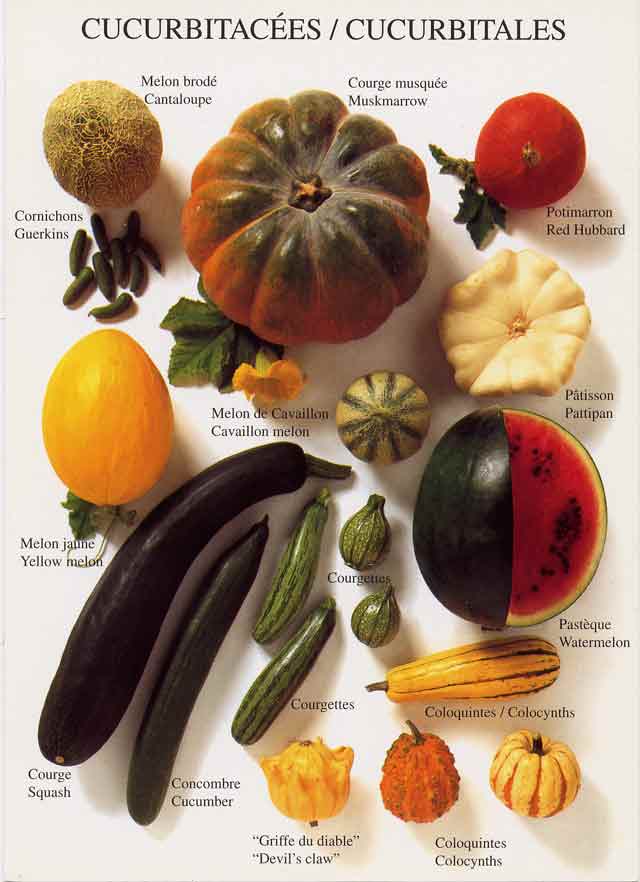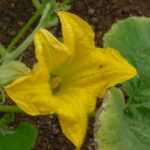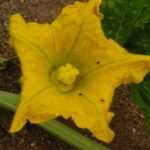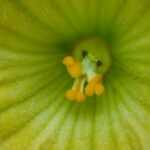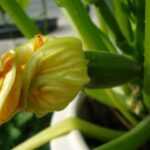DON’T MISS TAMIR’S EXTRAORDINARY BLUEBERRIES!
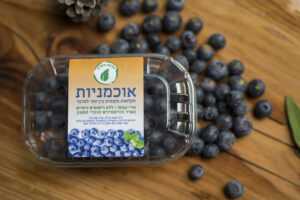
Blueberries need special conditions to best grow, including acidic soil and especially beneficial cold spells. To maintain an ideal level of acidity in the soil, Tamir’s blueberries are grown on detached beds inside large containers, receiving (non-organic) fertilization, but never sprayed.
Blueberries are rich in antioxidants, Vitamins C, K, and other minerals. They are known to prevent inflammation in blood vessels and to lower cholesterol. They are recommended as a fruit portion for diabetics, as these berries can lower sugar levels in the blood. And we haven’t even mentioned their tantalizing flavor…
Price: 18 NIS per 125-gram package
(a money-saving 500-gram package will be available as soon as the yield increases)
Blueberry season is short! (Only two months, and then followed by the raspberry season, inshallah). So, hurry and add blueberries to your boxes now via our order system.
__________________________
A SWEET TREAT AT A VERY SPECIAL PRICE
The graceful almond trees have now finished blossoming, and the almonds are already ripening on the branches. In their honor, Chubeza is delighted to offer a sale on Holy Butter’s delectable Almond Butter and Peanut Butter!
2 Containers of Peanut Butter: 48 NIS
2 Containers of Almond Butter: 72 NIS
Supply limited! Hurry and add these delicacies for delivery in your boxesvia our order system!
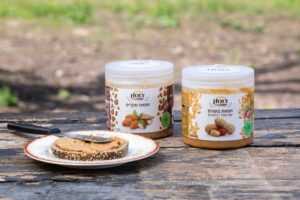
___________________________________________________
MAY DAY!
On May 1st this week, the world marked May Day, known today primarily as International Workers’ Day, but this date commemorates an age-old traditional holiday for the workers, primarily women. The Roman goddess Maia (AKA Bona Dea, the “good goddess”), the goddess of Spring, of fertility, healing, and growth, for whom the month of May was named. The literal meaning of Maia (and consequently the month of May) is “greater,” apropos for Spring – with greater daylight and higher temperatures which transform nature into a frenzy of green. Every blade of grass and tree begin to thrive, bursting with the energy of growth. May 1st and May 15th became major Pagan celebrations honoring Maia, revolving primarily around plants, flowers and water sources. These celebrations were strictly For Women Only, with men prohibited from joining. Surrounding her temples, Maia’s priestesses cultivated gardens of medicinal plants with which they treated the sick.
In the contemporary 19th and 20th centuries, May Day (May 1st) became adopted by Socialists, Communists, and labor parties and constituents as an International Worker’s Day. As a symbol of the struggle for workers’ rights, May Day was celebrated with parades in the streets and picnics in parks. This new expression of workers’ rights was spurred by the mass demonstrations staged in Canada and the USA in the 1870-80s demanding that the working day be limited to 8 hours. Over the years, the holiday has expanded to numerous countries round the globe. Even today, in our capitalist world, workers worldwide mark May First as Workers’ Day, when they remain home from work, hold assemblies and parades, and raise contemporary workers’ rights issues to the public agenda and awareness.
In honor of May Day this year, and in honor of the spring month of the goddess Maia, we salute the employees of Chubeza (both men and women) who are willing to rise for work in the fields, planting, sowing, weeding, fertilizing, harvesting and packing all year round – in rain, wind, and blazing sun. We thank them for their hard work, willingness and efforts, and for the initiative and responsibility they take. We know that without you, there would be no Chubeza. Thank you all, and happy May Day!
===
Over the past few weeks, you’ve been receiving one of the first vegetables of spring – squash! And there’s more varieties on the way! Squash comes in a burst of colors, from the light Galilean squash and dark green zucchini to the yellow zucchini and the striped varieties. As the leader of the band, we happily dedicate a special spring Newsletter to this remarkable vegetable.
Squash belongs to the prominent Cucurbitaceae family, a very diverse, widespread clan whose members are grown primarily for food, but also for other interesting uses. Within the subdivision of cultivated plants, the family tree splits off into five main branches: 1. cucumber, fakus and melon; 2. watermelon; 3. various types of pumpkins and squashes; 4. the decorative, inedible pumpkin used for decorative purposes and to make serving utensils and musical instruments; and 5. Lupa pumpkins, whose skin is used to create natural sponges.
Pumpkins and squash are close cousins with a range of different characteristics:
Pumpkins are harvested at maturity after a long growth period of 3-5 months, when their shell is hard and the seeds within are stiff and plump. (Usually, we seed them before cooking.) Conversely, squash is harvested young, after only one or two months of growth. Its peel is still soft, and chafes easily. The seeds are thin and barely discernible, and consumed along with the vegetable.
Squash and pumpkins are natives of Central America. Columbus introduced them to the Europeans, who first grew them only in botanical gardens, enjoying their beautiful blossoms. The Israelites, pleading “We remember the fish we ate in Egypt at no cost–also the squash, melons, leeks, onions and garlic…” apparently were not craving what we call squash, but probably the fakus, their African/Mid-Eastern cousin that grew at the time in Africa and the Middle East. He received his Hebrew name Kishu from the Arabic, Kusa (from Acadian), with its formal name being Kishu Pumpkin.
Even within its very own family, squash varieties vary from one sibling to another. The Mid-Eastern squash is chubby and light green. His longer and thinner brothers, the zucchinis, received their name from the Italian zucca for pumpkin, thus “a small pumpkin.” Chubeza grows dark green, yellow and striped zucchini. And there are also round squash varieties used to stuff, and even beautiful flower-shaped squash

Preparation for squash season starts here at the end of winter. We sow our squash seeds in January-February when it’s still mighty cold. To protect them, we cover the earth with a plastic surface, and cover the seeds with another plastic cover to insulate them from the cold. The result is a sort of tunnel that heats up from the sunrays and acts as a shield from the biting frost and any end-of-winter storms. Usually in the first rounds, we use transplants as well as seeds. The seeds need relatively high temperatures in order to sprout, while transplants have priority since they are more mature and can grow in lower temperatures as well.
In the annals of Chubeza, there were years when our first squash crops suffered a mysterious disappearance due to the young sprouts being eaten, probably by crickets or other earthy inhabitants. This was another reason to choose transplants during this season, attempting to outwit the pests.
When wintertime makes room for spring and it gets too hot under the plastic, we cover the squash plants in Agril – a cloth made of non-woven material. These sheets are very thin but insulated. They are not opaque, allowing the sunrays to penetrate, but are relatively strong. In winter we use Agril to protect the delicate greens from possible hail damage, and in springtime we spread it over the Cucurbitaceae family in the first stages of their growth to protect them from insects.
These aren’t your average vegetarian insects who need to feast on some squash greens, but rather flies, mosquitos and other fly-by insects who merely wish to land a hand or leg on the squash. The problem is that they aren’t great about hygiene, and therefore transmit viruses and diseases that damage the young squash plants. The viruses and leaf diseases are the worse problems this gourd family encounters, with the squash, fakus, melons and various small pumpkins being the most sensitive of all. Which is why we cover them with cloth as they start their lives in the world, just like we would put up a screen at home to prevent flying insects from entering our living space. Once the squash begins to bloom, we remove the cover, because it’s a whole new concert now, and for this segment we do need the humming of flying insects…
So how does squash move from being a green, impressive plant to ripening and bearing fruit? Along the way, there are the big, beautiful yellow flowers, lovely to look at and particularly attractive to yellow-loving pests. The squash plant bears two types of flowers: male and female (everything written about squash holds true for pumpkins, cucumbers, melons, watermelons, fakus and the rest of the Cucurbita or gourd family). Both types of flowers resemble each other from afar, but when you look closely, the differences are evident.
The insects, thrilled by the bright yellow, enter the male flower, have their fun, and gather some nectar and pollen that look like this:
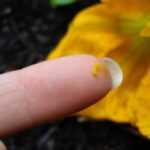
Then they move on to frolic in the next nearby playground, the female flower, spreading the male pollen all over. The now-fertilized female flower closes and shrinks, and at the end of the process looks like this:
If you look closely, you will see that at the edge of this flower, a fresh, new little squash is growing. It’ll only take him a few days before he is ready for careful and delicate picking, so as not to scratch or damage the shiny, delicate peel. Squash grow so quickly that we harvest them daily. A squash forgotten on the bush will be discovered a few days later in monster-like dimensions…
Squash is low in calories and high in dietary fiber. It contains magnesium, potassium and folic acid, Vitamins A and C and other antioxidants. Zucchini has a fresh, neutral flavor (some call it bland), but no need for a PR campaign: its neutral taste is probably the ingredient that made zucchini a favorite child in almost every country. In France they are used in ratatouille and quiches; in Italy they are prize components of caponata, frittata, antipasti and pasta primavera. The Italians also harbor a special affection for stir-fried zucchini flowers. Romania and Bulgaria cook it in a givetch, in Turkey it stars in patties, in the Middle East one can stuff it with rice and chopped meat, and Iraqis use squash generously in kubeh soup or sauce. In the Far East, zucchini and squash are stir-fried together in a wok, while in the United States they make their way into yummy bread and zucchini jam……
But hey, zucchini can also be eaten without cooking, frying or baking at all. Just squeeze them to make squash juice, a great detox for the body, or enjoy them fresh in your salad, a la cucumbers. On days when cucumber shortages struck Chubeza, we cheerfully chopped zucchini to fill our family lunch salad, which was polished off in seconds.
And on this optimistic and yummy note, we wish you all a good, calm week,
From the entire Chubeza team
_______________________________________
WHAT’S IN THIS WEEK’S BOXES?
Monday: Lettuce, parsley root/garlic, zucchini, beets, carrots, potatoes, parsley/coriander, Swiss chard/kale/New Zealand spinach, tomatoes, cucumbers, onions.
Large box, in addition: Turnips/cabbage/eggplant/peas/sweet potatoes, fennel/kohlrabi, celery.
FRUIT BOXES: Oranges/clementinas, red apples/nectarines/loquat, avocados, bananas, pomelit.
Wednesday: Lettuce, zucchini, beets, carrots/sweet potatoes/slice of pumpkin, potatoes, parsley/coriander, New Zealand spinach, tomatoes, cucumbers, onions, celery.
Large box, in addition: Swiss chard/kale, turnips/cabbage/peas/fennel/kohlrabi, parsley root/garlic/eggplant.
FRUIT BOXES: Oranges/clementinas, red apples/nectarines/loquat, avocados, bananas, pomelit.

